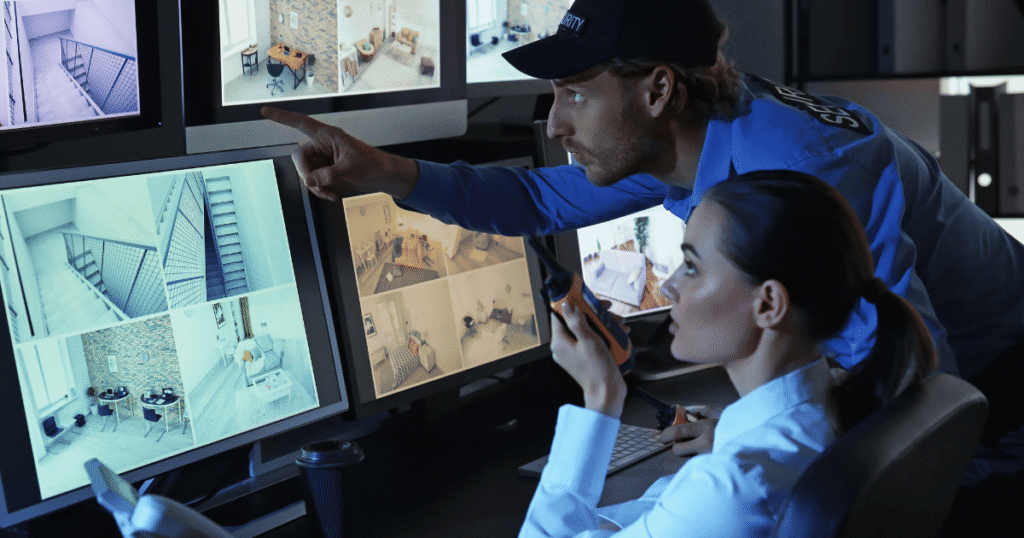
Types of Security Surveillance: Top Options for 2025
The need for advanced surveillance systems has never been more critical. Modern surveillance goes well beyond traditional cameras, integrating a range of technologies that enhance both physical and digital security. Companies are deploying diverse surveillance systems in tandem, creating robust security frameworks that can quickly adapt to new threats while ensuring operational efficiency.
To stay ahead of evolving security risks and to develop a tailored surveillance strategy for your organization, reach out to SPADE Security today! Let’s secure your future together.
The 6 Types of Security Surveillance
1. Physical Surveillance: Traditional Approaches in Modern Contexts
Physical surveillance remains foundational to comprehensive security strategies, combining human observation with advanced technological tools. This approach involves direct monitoring by trained personnel who can adapt to changing situations and provide immediate response capabilities.
Modern physical surveillance incorporates sophisticated equipment including high-resolution cameras, thermal imaging devices, and communication systems that enhance traditional observation methods. Security professionals use these tools to monitor large areas efficiently while maintaining the flexibility to respond to unexpected situations.
SPADE Security Services exemplifies this evolution, offering 24/7 patrol and monitoring services through licensed security officers who combine traditional surveillance techniques with advanced technology. Their veteran-founded approach, led by Marine Corps veteran Pranil Shankar, brings military discipline and strategic thinking to civilian security applications.
Recent case studies demonstrate the effectiveness of integrated physical surveillance approaches. AI-powered systems now track foot traffic, optimize store layouts, and adjust staffing in real-time, providing tangible operational benefits beyond basic security monitoring in retail environments.
2. Electronic Surveillance: The Backbone of Modern Security
Electronic surveillance forms the foundation of contemporary security systems, utilizing cameras, sensors, and monitoring equipment to provide continuous coverage across multiple locations. These systems capture and analyze data automatically, reducing human resource requirements while maintaining comprehensive situational awareness.
Modern electronic surveillance systems feature remote access capabilities, automated alert generation, and integration with other security infrastructure. The global surveillance camera market experienced rapid expansion from $38.89 billion in 2024 to an estimated $43.56 billion in 2025, demonstrating significant investment in these technologies.
SPADE Security Services leverages advanced CCTV and IP camera systems that enable real-time monitoring and swift threat response. Their approach emphasizes comprehensive coverage through networked camera systems that can monitor extensive areas while providing centralized control capabilities. This integration allows different manufacturers’ cameras and multiple locations to operate within unified platforms.
Manufacturing facilities have achieved remarkable results through strategic electronic surveillance implementation. AI-enabled surveillance systems now monitor hazardous zones, automatically flag safety violations, and track compliance, reducing workplace incidents while improving operational efficiency through real-time quality control integration.
3. Computer and Cyber Surveillance: Safeguarding Digital Frontiers
Computer and cyber surveillance protect digital assets through continuous monitoring of network traffic, data transfers, and system activities. These surveillance methods detect unauthorized access attempts, identify suspicious patterns, and prevent data breaches before they cause significant damage.
Information security products and services markets exceeded $200 billion in 2024, reflecting substantial investment in digital protection technologies. Advanced cyber surveillance employs artificial intelligence and machine learning algorithms to analyze massive data volumes and identify threats that traditional security measures might miss.
SPADE Security Services provides comprehensive cybersecurity monitoring and response services designed specifically for digital asset protection. Their proactive threat detection capabilities help organizations stay ahead of potential cyber threats through continuous system monitoring and rapid incident response.
4. Social Media Surveillance: Monitoring the Social Sphere
Social media surveillance analyzes publicly available content across digital platforms to identify trends, threats, and connections relevant to security objectives. This approach leverages specialized software and AI-driven tools for sentiment analysis, trend detection, and open-source intelligence gathering.
Organizations use social media surveillance for brand protection, threat assessment, and early warning systems that detect potential security issues before they escalate. Security teams monitor public posts, comments, and interactions to understand public sentiment and identify individuals or groups that might pose threats to organizational interests.
The effectiveness of social media surveillance depends on sophisticated analytics tools that can process vast amounts of unstructured data quickly and accurately. These systems identify patterns, relationships, and anomalies within social media content that human analysts might overlook or take much longer to discover.
5. Financial Surveillance: Ensuring Secure Transactions
Financial surveillance monitors transactions and financial behaviors to detect fraud, money laundering, and regulatory violations. These systems analyze large volumes of financial data using artificial intelligence algorithms and secure databases to identify suspicious patterns and ensure compliance with legal standards.
Advanced financial surveillance systems employ machine learning techniques that adapt to evolving fraud patterns and improve detection accuracy over time. These technologies can identify subtle anomalies within transaction data that indicate potential criminal activity or regulatory violations requiring investigation.
Delta Dental of California’s response to a MOVEit Transfer vulnerability demonstrates how organizations strengthen financial surveillance following security incidents. The organization implemented regular vulnerability scanning, faster patch management, and enhanced digital forensics capabilities for ongoing threat detection.
6. Biometric Surveillance: Leveraging Physical Traits for Security
Biometric surveillance uses unique physical characteristics such as facial features, fingerprints, iris patterns, and voice recognition for identification and authentication purposes. Growing use of biometric technologies for secure and automated monitoring reflects increasing adoption across security applications.
Modern biometric systems employ artificial intelligence to improve accuracy and reduce false positive rates while processing identification requests rapidly. These technologies provide strong authentication capabilities that are difficult to forge or compromise compared to traditional credential-based security measures.
Ensuring the right tools are in place to secure data across a sprawl of applications and environments is critical as biometric surveillance systems become more sophisticated and interconnected. Managing and securing these digital identities stands out as a top challenge for security strategists.

Innovative Tools and Techniques in Surveillance
AI and Machine Learning in Video Surveillance
Artificial intelligence and machine learning technologies revolutionize video surveillance by enabling automated threat detection, behavioral analysis, and anomaly recognition capabilities. The global AI in video surveillance market is expected to surge from $3.90 billion in 2024 to $6.81 billion in 2025, representing exceptional growth in this sector.
AI-powered surveillance systems process enormous amounts of video data in real-time, identifying patterns and behaviors that indicate potential security threats. These systems learn from historical data to improve detection accuracy while reducing false alarms that can overwhelm security personnel and diminish response effectiveness.
Educational institutions demonstrate AI surveillance effectiveness through systems that proactively identify risks such as unauthorized individuals or emergency situations. When suspicious activity is detected near monitored entrances, these systems instantly send SMS alerts with images to security teams, broadcast warnings, and escalate to law enforcement when necessary.
It’s crucial to ensure these systems are secure by design, where robust protective mechanisms and data guardrails are built into the foundations. Traditional application testing alone cannot address the complexities of AI-integrated surveillance systems.
Live Surveillance Monitoring with Real-Time Alerts
Live surveillance monitoring combines continuous observation with instant notification capabilities, enabling security teams to respond rapidly to incidents as they develop. This approach integrates AI-powered analytics with human oversight to enhance threat detection and verification capabilities.
Real-time alert systems can be configured to respond to specific triggers such as unauthorized access, unusual movement patterns, or equipment failures. These systems support proactive intervention by providing security personnel with immediate notification and relevant context for rapid decision-making.
The Arlington Texas Police Department case study demonstrates sophisticated threat detection through drone surveillance analysis. By analyzing historical drone flight data, they discovered unauthorized flights originating from specific locations, allowing for strategic camera placement and targeted signage that dramatically improved their ability to intercept unauthorized drones during major events.
SPADE Security Services offers remote video surveillance solutions that support off-site monitoring and management of security footage. Their approach allows prompt incident detection and response while reducing on-site personnel requirements, making comprehensive security coverage more cost-effective for organizations with multiple locations or limited resources.
Managed Surveillance Solutions for Businesses
Managed surveillance solutions provide end-to-end services including system design, installation, monitoring, and maintenance tailored to specific organizational needs. These comprehensive approaches reduce internal resource requirements while ensuring professional-grade security coverage and ongoing system optimization.
Over 83% of businesses are projected to adopt cloud-based surveillance solutions by 2025, indicating significant migration toward managed services that offer scalability and remote accessibility. Cloud-based platforms enable organizations to expand surveillance capabilities without substantial infrastructure investments.
SPADE Security Services exemplifies comprehensive managed surveillance through their integration of various security components into unified systems. With over 20 years of experience and 350+ completed projects, they provide strategic guidance on connecting access control systems with video surveillance, intrusion detection, and other security measures into cohesive platforms.
Property management companies have benefited significantly from integrated surveillance approaches. AI-powered systems now coordinate visitor tracking, multi-site security monitoring, and access control, all through unified platforms that improve tenant and guest protection while reducing liability exposure.
Compliance and Privacy Framework
Organizations implementing surveillance systems must navigate complex regulatory landscapes including GDPR, CCPA, and industry-specific requirements. The challenge of “navigating the complexities of digital identity management, multicloud environments and new data strategies” has become a priority for security teams as data becomes more decentralized.
Privacy considerations require careful balance between security effectiveness and individual rights protection. Organizations must establish clear policies governing data collection, storage, and usage while ensuring their surveillance activities support legitimate security objectives without overreaching into inappropriate monitoring practices.
Compliance frameworks should address data retention policies, access controls, and audit trails that demonstrate responsible surveillance implementation. Regular reviews ensure surveillance practices remain aligned with evolving regulations and industry best practices while maintaining operational effectiveness.

Strategizing Your Surveillance Efforts
Essential Steps to Enhance Your Surveillance Strategy
Developing effective surveillance strategies requires comprehensive security assessments that identify vulnerabilities and prioritize protection needs based on risk analysis and operational requirements. Organizations must evaluate their unique threat profiles while considering industry-specific regulations and compliance requirements.
Strategic surveillance planning emphasizes integration and interoperability to create unified security ecosystems that streamline monitoring and response capabilities. Successful implementations focus on scalable solutions that accommodate organizational growth without requiring complete system replacements or extensive reconfigurations.
SPADE Security Services provides expert guidance through security consulting services that help businesses identify and mitigate potential threats while enhancing overall security posture. Their collaborative approach develops customized security plans aligned with specific needs and budget constraints while optimizing resource allocation for maximum effectiveness.
Implementation should proceed in phases that ensure compatibility with existing systems while minimizing operational disruptions. Regular reviews and updates keep surveillance strategies current with evolving threats, technological advances, and regulatory changes that affect security requirements.
Selecting the Right Equipment for Your Needs
Equipment selection requires careful consideration of security objectives, site conditions, and budget constraints while evaluating factors such as coverage areas, image quality, remote accessibility, and integration capabilities. Organizations must assess reliability, scalability, and legal compliance to ensure their investments meet current and future needs.
Modern surveillance equipment should support advanced features including AI-powered analytics and high-resolution imaging that enhance security effectiveness while reducing false alarms. The IP camera market generated $14.3 billion in 2024 and is expected to grow to $16.2 billion in 2025, demonstrating continued investment in networked surveillance technology.
SPADE Security Services employs advanced drone video surveillance technology that provides comprehensive aerial monitoring capabilities for large or difficult-to-reach areas. Their unmanned aerial vehicles equipped with high-resolution cameras offer enhanced perimeter security, improved situational awareness, and cost-effective infrastructure inspections across various applications.
Equipment selection should also consider storage and accessibility requirements, with many organizations opting for hybrid solutions that combine local and cloud storage capabilities. This approach provides flexibility while ensuring footage remains accessible during emergencies or system maintenance periods.
Conclusion: Harnessing the Power of Surveillance Responsibly
The diverse types of security surveillance available in 2025 offer unprecedented capabilities for protecting people, property, and information across multiple domains. Organizations can choose from physical surveillance, electronic monitoring, cyber protection, social media analysis, financial oversight, and biometric identification to create comprehensive security strategies tailored to their specific needs.
SPADE Security Services demonstrates responsible surveillance implementation through their commitment to regulatory compliance and privacy-conscious deployment practices. Their expertise in California’s regulatory environment, combined with comprehensive security solutions, exemplifies how organizations can harness surveillance power while maintaining ethical standards and public trust.
The future of surveillance lies in integrated approaches that combine multiple surveillance types with advanced technologies including artificial intelligence, machine learning, and predictive analytics. Organizations that invest in comprehensive surveillance strategies while maintaining responsible implementation practices will be best positioned to address emerging security challenges effectively while protecting the privacy and rights of individuals within their operational environments.




